The Northrop F-5 Enthusiast Page - Home
Hukbong Himpapawid ng Pilipinas - Philippines Air Force
Last update 04-09-2022
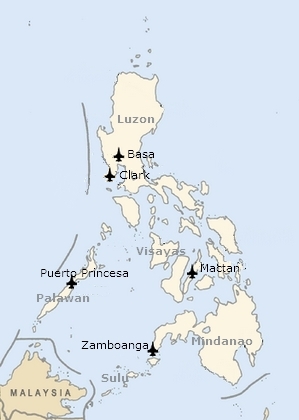


Credit: Roundels of the world
Philippine bases are named after a person importance to the Air
Force. They are listed here with their nearest city and their
official name:
Manila
- Clark AB
Manila
- Basa AB
Mactan - Cebu - Ebuan
AB
Puerto Princesa - Bautista
AB
Zamboanga
- Andrew AB
PROCUREMENT
Discussions
were held in 1964 between the Philippine and the US government to seek
a replacement of the elderly North American F-86F and F-86D at the time
in use as fighters. The offer for Northrop F-5s to be
received
under MAP aroused little interest as the local goverment preferred
to receive two Squadrons of Lockheed F-104.
This request was not
accepted and two Northrop F-5 Squadrons were initially planned August
27th, 1965 under the Philippine-US military agreement with assignment scheduled
as follows: 9 aircrafts from US Fiscal
Year 1964, 10 from FY 1965, 3
from FY
1966, 7 from FY 1967, 14 from FY 1968, for a total of 43 aircrafts.The
first seven, Fiscal Year 1964, Northrop F-5A and two Northrop
F-5B were handed over in
July 1965 at
McClellan AFB (USA), arrival in to the Philippines
followed on 25-10-65, but due to a reduction of military aid
and changes of priorities only one unit (6th
Tactical Fighter Squadron) could finally be re-equipped with
Freedom
Fighters, further deliveries following with 9 Fiscal Year single- and 1
two-seater, 3 F-5A from FY 1966. Six instructor pilots and 50 maintenance crew members attained training courses at Williams AFB in 1965.
Aircrafts
were delived in all
metallic colour, last five digits of serial was painted on tail plus the code
FA- and the last three serial digits next to the nationality markings. Some were named and wore the name on the
nose, initially simply written on the metal, later embedded in a nose badge. By Jamuary 1966 7 Northrop F-5A and 2 Northrop F-5B were on training status.
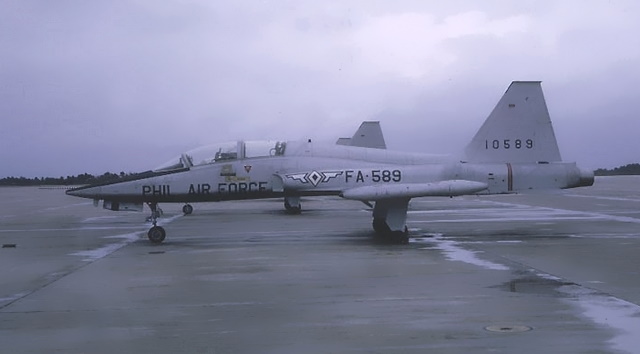 Photo: Archive The Northrop F-5 Enthusiast
Photo: Archive The Northrop F-5 Enthusiast
Northrop F-5B in the orignal silver
colours and FA-589 code, on a rainy day at Basa AB, 1968
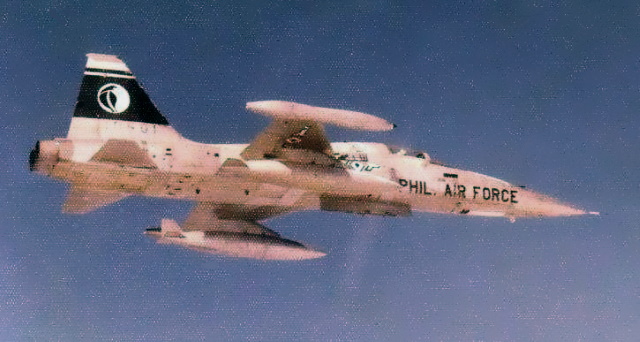
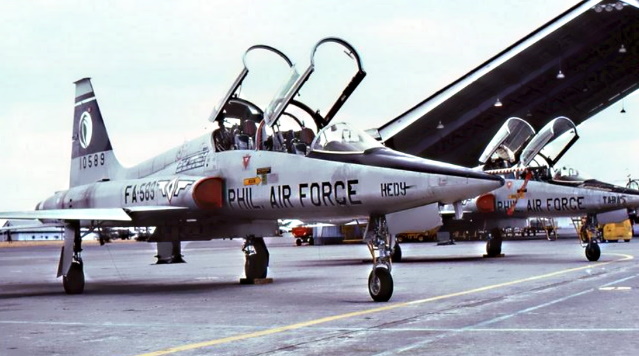
Northrop F-5A In-flight view in early Squadron tail, overall metallic colours Photo: Philippine AF Full early Squadron markings
and named Hedy seen at Clark AFB in 1972, together
with F-5B
named Tabas (serial?) Photo: Archive The Northrop F-5 Enthusiast
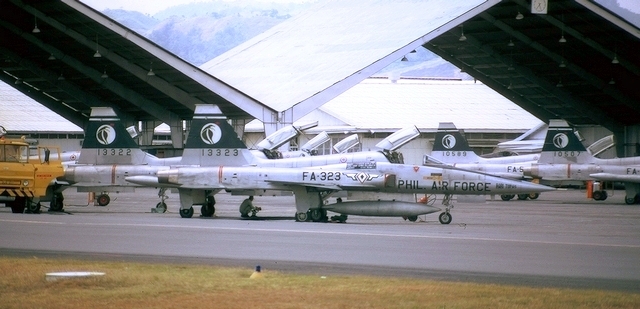 Photo: Archive The Northrop F-5 Enthusiast
Photo: Archive The Northrop F-5 Enthusiast
Line-up at Basa AB in 1972 with 6th Squadron tail badge and aircraft name on nose.
Some changes to the colours was made during the years: a very dark blue stripe with a cobra (Squadron name) was worn on the tail during the years 1971-1972.
6th Squadron's tail markings were deleted,
replaced by Philippine colours seal, see below.
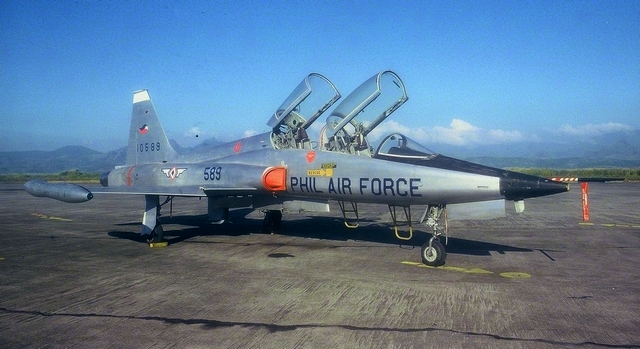
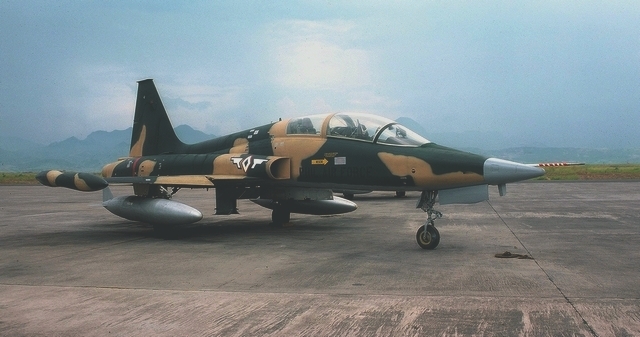
Northrop F-5B 10589 at Basa AB seen here in December 1980, in silver colours, without FA- Northrop F-5B 10589 at Basa AB on a foggy day in May 1976
code, seal first version on tail.
Photos: Archive The Northrop F-5 Enthusiast This camouflage was experimentated, but not adopted.
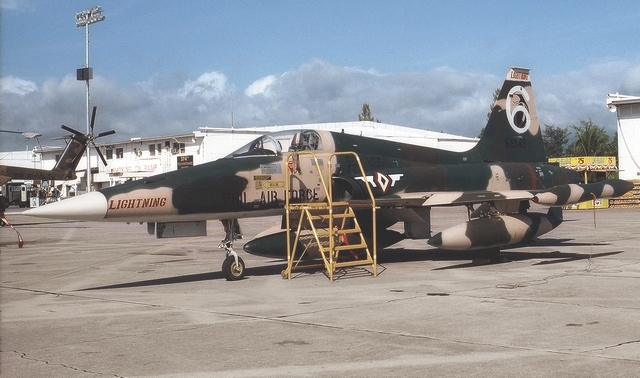 Photo: Archive The Northrop F-5 Enthusiast
Photo: Archive The Northrop F-5 Enthusiast
Some had special 6th Squadron colours on the tail Northrop F-5A 69148 seen in 09-76,
named Lightning, in an striking camouflage scheme, inclusive tanks
On
14-05-76 the Republic of Phillpines requested information regarding the
delivery of 11 Northrop F-5E; the USA answered that the Letter of
Offer could only be deivered by October 1976, though Philippines asked
for an earlier answer. the deal was not finalised and in late 1977 35 Chance-Vought F-8H Crusader were
actually bought, 25 refurbished and 10 for spare parts.
By 1977 the aircraft had lost their FA- code and
the "Blue Diamonds" sign was painted on the nose
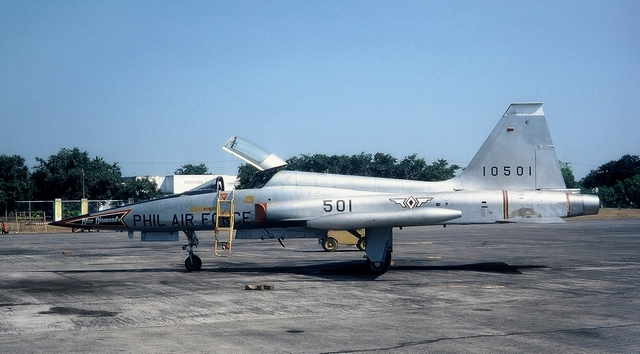
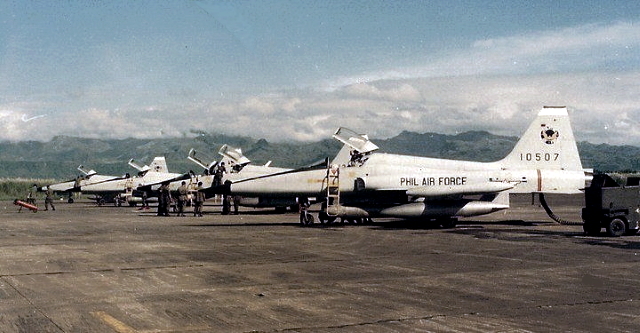
Northrop F-5A 10501 seen in April 1979
Photo: Archive The Northrop F-5 Enthusiast
Line-up of grey Northrop F-5As, seen at Basa AB
These aircrafts suffered with the years from normal losses,
aging, poor maintenance and shortage of spare parts due to
funds mismanagement by the government and worsening of the country's
economical situation.
A limited operational bolster and
extension of life was implemented, including a structural and limited
avionics, with the help of the USA company Tiger Century Aircraft (when?).
Additional
aircrafts, to keep a limited strike capability, were procured from the
Republic of China and the Republic of Korea Air Forces; unfortunately
it is not clear when/how many have been actually received.
Following have been sighted:
ex Republic of China beginning in 1989 one single- and one double-seaters when
a test pilot checked locally the aircrafts out and one pilot was
trained by the 16th Republic of China Group on the double seater,
followed
in 1993 by 1 Northrop F-5A, this last as an exchange against a North American F-51D exposed at the
Air Force museum at Manila;
three single-seaters received from Korea in September 1995r, followed by another five in October 1998;
in August 1997 two former Jordanian/US civilian Northrop F-5As, on the US civil aviation
register for a short time. Four former Republic of China, seen at Mojave airport 1988/early 1989, have also been mentioned
but there have never
been reports to be in the Philippines.
5th Tactical Fighter Wing - 6th Tactical Fighter Squadron "Cobras"
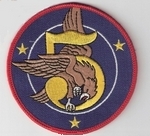
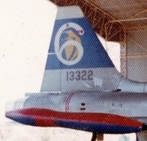
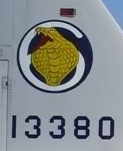
Patch
5th
Wing Tail badge 1975, red/blue tank Badge 6th Squadron
The 6th Tactical Fighter Squadron was part of the 5th
Tactical Fighter Wing,
based at Basa AB, equipped with North American F-86F when it
received
its first Northrop F-5A in 1965. Its main duties were daytime air
defence cover, armed with AIM-9B Sidewinders, over the islands of Luzon and Visayas (all weather
interception being till June 1968 assured by Philippine North
American F-86D, later delegated to USAF
units equipped
with appropriate aircrafts) and ground attack
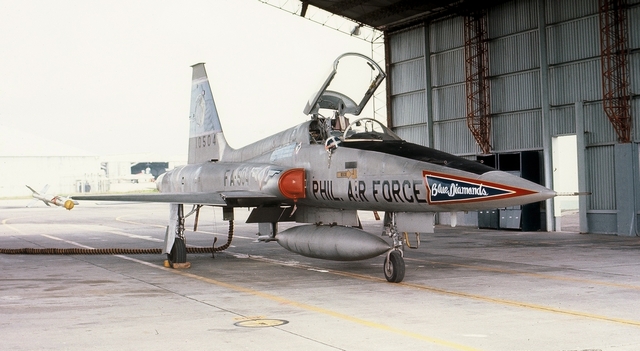
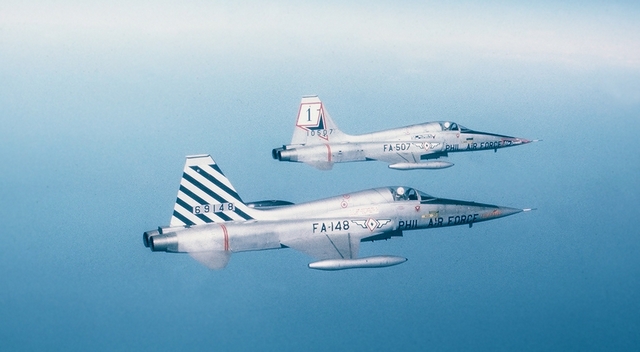
Northrop F-5A 10504 in the alert hangar at Basa AB in August 1975 armed with AIM-9B
Blue Diamond serial 10507, code "1", seen 1973 in formation with Squadron Commander
Sidewinder. Of note tail with blue stripe and big 6 (Squadron number).
Northrop F-5A, tail painted serial 69148, named Lightning.
Photos: Archive The Northrop F-5 Enthusiast

Part of the unit was the Blue Diamonds
acrobatic team. It was part of the 7th Tactical Fighter Squadron with 9
North American F-86F till 1966. The team was reassigned to the 6th
Squadron
with the arrival of the Freedom Fighters; it flew its first
exhibition on 02-05-68 with six aircrafts.
The year 1968 brought also
the first (and only) transfer abroad: an acrobatic demonstration took
place in the Republic of China (Taiwan).
During the years the number of aircraft varied: in 1971 till 1973 five aircrafts. The year 1974 saw
the reduction to 4 due to the world's fuel crisis; on 04-07-75 a single aircraft show took place,
in 1976 the team performed with two aircrafts, 1977
with four Freedom Fighters while in 1978 was formed by 8 pilots.
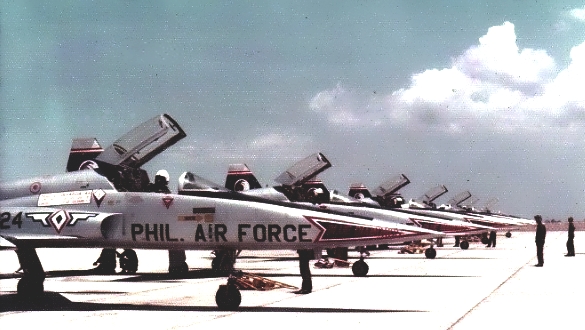 Photo: Militaryimages.net
Photo: Militaryimages.net 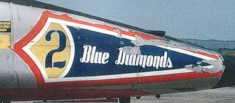

Photo
of good old times! First aircraft should be Northrop F-5A serial
13324/FA-324. Above: nose inscription
First variant (worn-out)
Final variant
Of notr red (instead of white) Blue Diamondsnose inscription, possibly at Basa AB.
Exhibitions were resumed in 1986 with 6 Northrop F-5A, to stop the same
year and being resumed in 1995/19967/1998 and, definitely, ending with one
exhibition at the 52nd PAF Anniversary Celebration in 1999.
Aircrafts
were already at the time too fragile to allow acrobatic manoeuvers.
OPERATIONS
Regular
patrol flights were undertaken in 1968 from Mactan AB to Sabah, cannons
fully armed and three external tank due to distance.
Aircrafts
of the 6th TFS participated betwen 1971 and 1973, together with
North American T-28D and F-86F, to the fighting against
various insurgents in Luzon island and the Visayas islands, mainly
muslim, among
which the important battle for
Sibalu Hill (Jolo) in November 1972.
Northrop
F-5A and F-5B from Mactan AB (together with North American F-86F and Lockheed T-33A) flew between 1st an 09-12-74 again against insurgents gunnery
straffing, bombing missions destroying several
boats, ammunition and
fuel dumps in the area of Zamboanga del Sur. This
was made difficult by their fuel consumption at a distance of more than
700 miles (back and forth) plus loiter time and complicated by
possible battle damage.
The mid '70s also brought several changes:
Armistices were declared
and broken several times in the following years, resulting in a continous
guerrilla war,
mainly fought by COIN aircrafts. These fightings are still going on today.
SEATO Organisation (including United States of America, France, Great
Britain, Australia, New Zealand,Thailand, Pakistan) was
disbanded on 20-02-76 (after 22 years), curtailing the source of much
Philippino equipment,
including aircrafts; the final joined excercise
was held in the Philippines in February 1976.
By
1977 there were 9 active single-, 2 double-seaters plus 2 others
F-5A withdrawn from use. Most were deployed to Mactan to
fight insurgents in the Visaya Islands; there were 7 single- and 2
two-seaters in
November 1977.
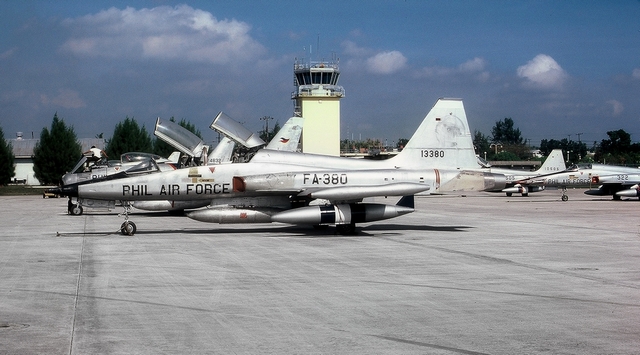 Photo: Archive The Northrop F-5 Enthusiast
Photo: Archive The Northrop F-5 Enthusiast
Northrop F-5B 13380 at Mactan AB in February 1977 equipped
with a maximum load of tanks to
increase range, in company of several F-5A and North
American F-86F.
Another duty was the defence of Philippine interests over the the Spratley Island (called Kalaayan by the Philippines), secured
in 1977 and beginning 1978 by some plus North American
F-86F, based at Puerto Princesa.
Air combat, particularly using the Colt-Browning M-39 cannons, was trained intensively using an underbelly target, as shown applied to Northrop F-5A 69150 in December 1980, or an underwing one.
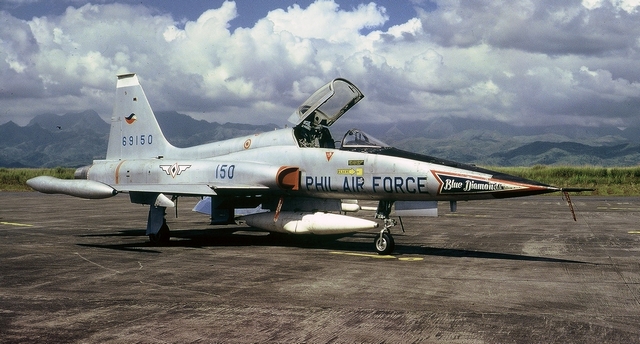 Photo: Archive The Northrop F-5 Enthusiast
Photo: Archive The Northrop F-5 Enthusiast
Northrop F-5A 69150 at Basa AB in
September 1980 with underbelly target.
Philippine Northrop F-5A participated to the "Cope Thunder" together
with USAF aircrafts during various year.
The year 1984 saw the participation from Clark AFB of USAF F-15, F-4E,
T-33A, US Navy A-6, Indonesian F-5E plus various transport, AEW
aircrafts and helicopters.
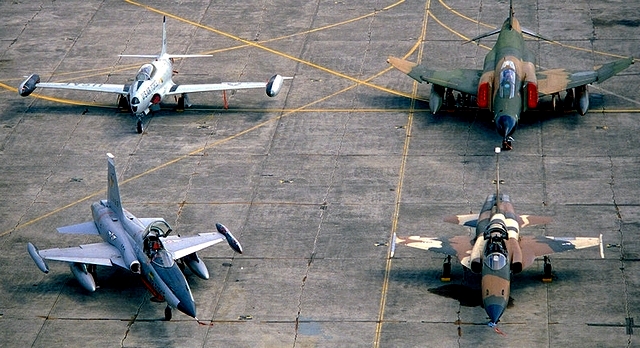
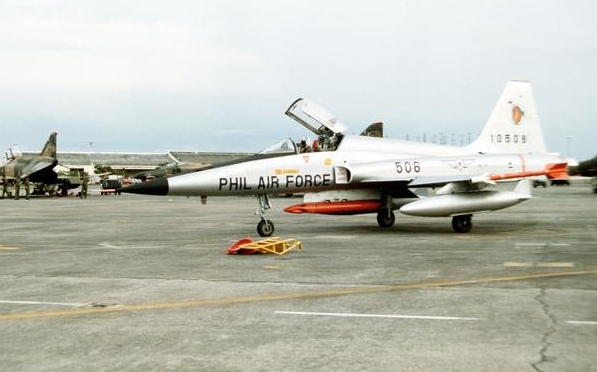
Northrop F-5A 10499 posing at Clark AFB on 16-02-84 with 26th TFTAS Northrop F-5E,
The 6th Fighter Squadron was also present to the "Cope Thunder '85" edition. Above
Lockheed T-33A and
McDonnel F-4E 3rd TFS during exercise "Cope Thunder '84".
Northrop F-5A 10506 pictured on 11-01-83 during rolling for
take-off at Clark AFB
Photos : The US National Archives
with AIM-9B Sidewinder and rocket launcher
In a secret letter dated 14-05-76 sent to the US it requested to procure eleven Northrop F-5E under MAP. This was not supported by the local embassy but it had no follow-up.
Instead twenty four Chance
Vought F-8H had taken air-defence role over from 1978 but in 1988 they had to
be retired due to corrosion, high operating costs and lack of spare parts,
leaving again the Freedom
Fighter as the only fighter available.
Unusal
was the participation of four Freedom Fighters to the film "Apocalypse
now" in 1979, simulating a napalm bombs attack in South Vietnam. They actually dropped cansters that looked like napalm canisters;
special effects set a huge fire of 1'200 gallons of gasoline. Later,
in 2000, the Freedom Fighters participated to a film called "Thirteen
days", referring to the 1962 Cuban Missile Crise. The Freedom Fghters
were
painted in USAF coours and operated from Clark AFB (Philippines).
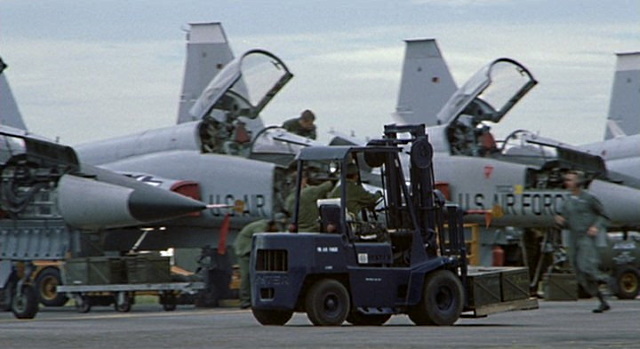
A scene from the film Thirteen Day Northrop F-5As in US Air Force markings
Overthrow of
the Marcos government in February 1986 brought unrest in the country; the 5th Wing didn't participated to operations.
During a
military coup on 01-12-89 till 09-12-89 several Northrop F-5A and F-5B and their pilots, temporarely based at Mactan AB, were captured
by insurgents; only four F-5A/F-5B under maintenance at Basa AB
remained
at government
disposal for the defence of Manila. They were immediately put back into operation to support the lealist forces.
Two
single- and one doubleseater established combat air
patrols with the order to shoot rebel aircrafts down. Several rebel
North American AT-28D were intercepted bu not shot down as the pilots
wanted to avoid
shooting on collegues; they were forced to return to
their home-base Sangley Point AB. An F-5s
rocket attack against this base followed to put the T-28Ds out of use but was
ineffective as the rebel aircrafts were
purposely missed. A second,
cannons/rockets attack, was definitive when 3 Northrop F-5As damaged/destroyed
7 AT-28D and 1 Sikorsky AUH-76 at Sangley Point; unfortunately one
Freedom Fighter was lost in a
crash-landing on return to Basa AB. The following
day a mission, with unguided rockets, was flown against insurgents at Camp Aguinaldo Marine Camp in
Manila.
Finally the rebels surrended on 07-12-89.
By the beginning of the '90s only eight single- and two double-seaters were available, few being airworthy.
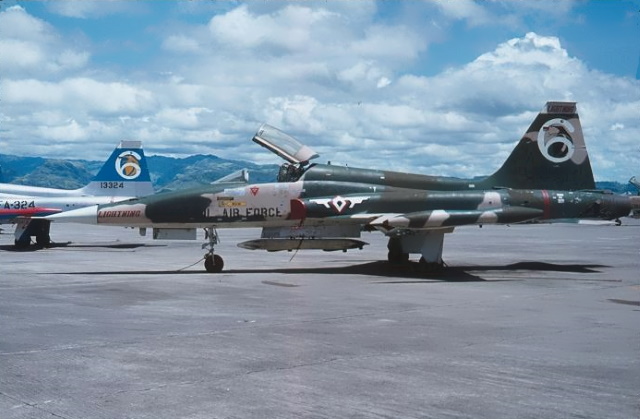
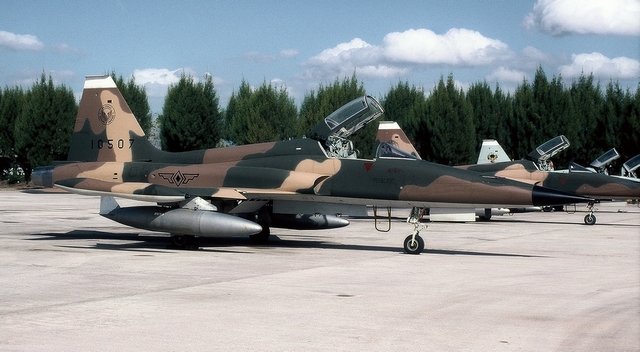
Picture
of camouflaged Northrop F-5A 10506 and metal 13324 with big
Squadron
Northrop F-5A 10507 together with a slightly different coloured example - Puerto Princesa AB March 1992
number
on tail, Lightning name, white
nose.
Photo:
unknown
Photo: Archive The Northrop F-5 Enthusiast
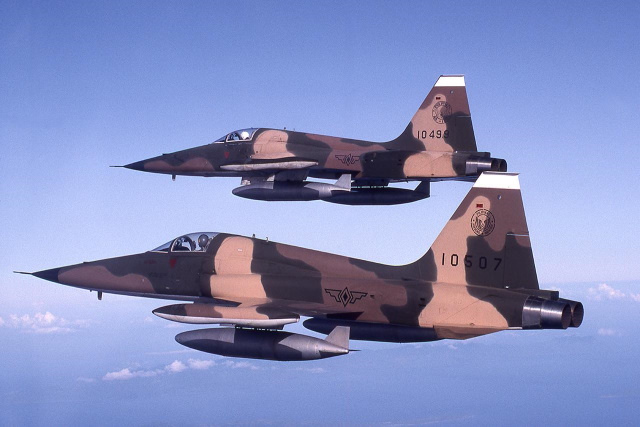 Photo: Peter Steinemann
Photo: Peter Steinemann
Camouflaged Northrop F-5A 10507 and 10499 in 1994, toned down nationality insignia
Following eruption of the approximately 20 kms
distant Mount Pinatubo in June/July 1991 Basa AB was damaged
considerably by ash. It seems that some F-5s were destroyed when an
hangar collapsed; the others
were transferred to Clark AFB, former
USAF base, where they remained.
Defence
funds became very scarce when US Military Assistance Program payments
were withdrawn following the transfer of Clark AFB from USA to
Philippine
possession on 26-11-91 and of Subic Naval Base on 26-11-92;
the radar
network had
to be closed leaving the Philippines without coverage and the Freedom
Fighters
were left without guidance.
Puerto
Princesa AB housed again in March 1992 some of the remaining airworthy
aircrafts, due to tension with China over the Spratley Islands. Some of
these had obtained in the meantime a new camouflage, (at least
1 Northrop F-5A) others were gray
painted (same as former Korean AF ones).
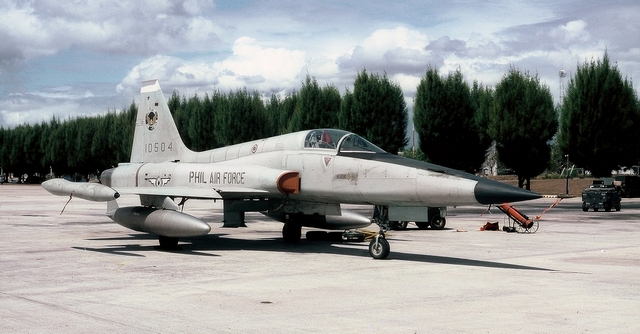
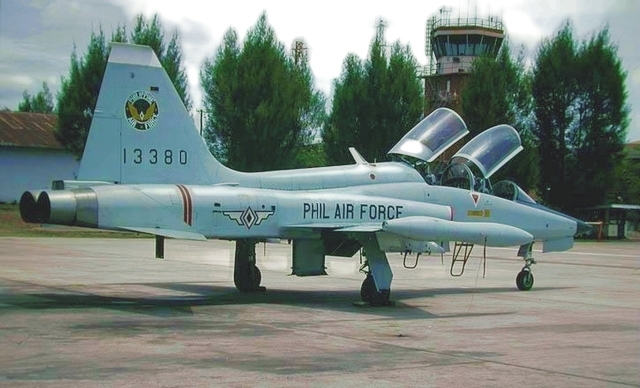
Northrop F-5A
10504 in last, worn out, gray colours - Puerto
Princesa AB March 1992
Receintly gray painted Northrop F-5B 13380 - Puerto Princesa AB March 1992
Photos: Archive The Northrop
F-5 Enthusiast
In 1994/1995 the Philippines came again in clinch with China People's Republic regarding
the control of islands and reefs in the Spratly archipelago and
Mischief Reefs, about 400 km west of the Philippine island of
Palawan. The only 5 airworthy Northrop F-5s were transferred immediately to the nearest airport, Puerto Princesa, but
returned to their home base when tension decreased. Their fighting potential
was very limited
because of the short endurance of the fighters and the
airframes fatigue did not allow sharp combat.
Very few remained operational: three single- one double-seater in 1991 and 1992, two in 1993 and
1994, five in November 2000, mostly affected by airleron cracks; air-to-air missiles AIM-9B Sidewinder were
anyhow refurbished in 1999.
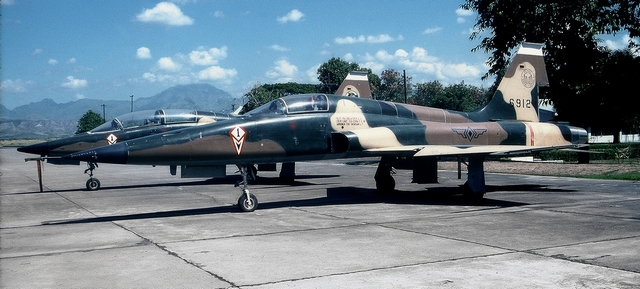 Photo: Archive The Northrop
F-5 Enthusiast
Photo: Archive The Northrop
F-5 Enthusiast
Camouflaged Northrop F-5A 69124 (without rudder) with toned down seal
and an unknown, possibly 13380, F-5B
with coloured seal, in May 1998. Both have the "Blue Diamonds" badge
with number 1 painted on the nose.
Some
relief for the ground-attack role was the modification of some of 24 Siai S.211 trainers received
in the early '90s; parts of
the Northrop F-5s were used to improve their light attack configuration: optical sighting
system, UHF radios, Head Up Displays and 20mm
cannons from retired airframes were incorporated in the former trainers.
At least 3 Northrop F-5As participated to the all-out war against muslim kidnappers in Sulu islands during May 2000.
They were not suited for this kind of war and were just used for a show of force by the Philippine
president; the same
aircrafts flew over the Manila presidential palace to oust the
president on 20-01-01.
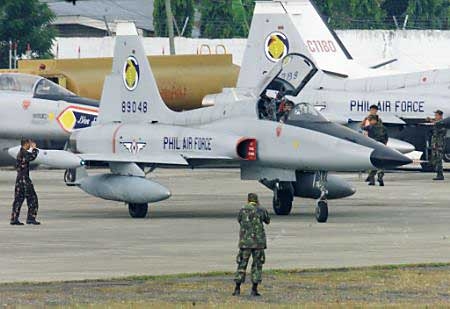 Photo: unknown
Photo: unknown
Northrop F-5A and B on readiness at Mactan AB
in May 2000
Almost
contemporanously, one Northrop F-5A and one F-5B, together with an Siai
SF.211, participated as interdiction aircrafts to the Special Troops
Exercise "Teak Piston 01-2" in January 2001 together with 2
special
operation USAF C-130 and 3 Sikorsky MH-53.
A new Air Defence Alert Center was completed by September 2001
at Clark AB, enabling partial control of Philippine territory and a scramble of
the Northrop F-5As on alarm. Unfortunately this was very short lived.
Excercise "Balikatan 02-2002" was held by at least two Northrops F-5A, with US Navy McDonald F-18 for two weeks.
WITHDRAWAL AND SEARCH FOR REPLACEMENT AIRCRAFT
A tentative
to buy Northrop F-5E/F-5F Tiger (Project Peace Magohany) took
place in 04-05-76 with the request to use USD 4.7m Fiscal Year 76 Foreign
Military Sales credit for an initial payment of 11 Northrop F5E, but
by 03-01-77 (the
expiry date) the US Letter of Offer had not been signed, due to the
desire to evaluate Chance Vought F-8H, Douglas A-4C and other fighters;
25 active and 10 Chance Vought F-8H for spare only were
bought in
1977.
By
1986 it was clear that the life of the remaining Freedom Fighters was
very limited. Several considerations were made to obtain new aircrafts; financial onea proved this impossible..
Preliminary discussions were held during this year with Korea to obtain 21
Northrop F-5Es and 3 F-5F as these were to be replaced by General Dynamics
F-16s; the government expected to raise enough funds from the
sale of Chance
Vought F-8H for the down payment but potential purchasers withdraw their interest and the deal fell through; in 1990 the General Dynamics F-16 was considered, but it was too
expensive. A less
expensive solution was sought in 1991 buying IAI
Kfir C-7, but its purchase was rejected in order not to increase the other
defence expenditures; also rejected was an offer during 1996 of up to 18 IAI Kfir-2000; one
MiG-29SE was even shown at Manila-Villamor AB in November 1994, though with little chance of an acquisition; another purchase attempt was
made in April 1997, when discussions were kept with a private
company in
order to obtain 13 Canadair CF-5A in return for mining rights,
but these didn't reach maturity. Also considered was the purchase of
former, stored Kuwaiti A-4KU; former Belgian Mirage 5, surplus French
Mirage F.1 and
(it seems) Russian MiG-21.
Alternative solution to extend the structural life of the available aircrafts for USD 50m, considered in February 1998, was fruitless.
Possible acquisitions of second generation fighters were former New Zealand
A-4K/TA-4K, Saudi Arabian F-5E/F, again without follow-up; political consideration stopped in 1999 the acquisition of withdrawn
from service
Republic of China (Taiwan) Northrop F-5E and F-5F, even if
these were offered at an friendship price, first to be first returned to the USA and later to be sold to the Philippines.
Third generation fighters were also on the shopping list: in USA stored Pakistani General Dynamics
F-16s (counter-trade with engine manufacturer Pratt-Whitney company
was considered), F-18C/D, Mirage 200-5,
Gripen.
In a final effort to have some sort of air defence/support for the army the option to upgrade its remaining Northrop
F-5A/F-5B was studied beginning 2002.
An offer by the Taiwanese Aerospace Industrial
Development Corporation Corp. of up to 26 former Republic of China
Northrop F-5E/F-5F was considered as well as looking at retired
Saudi and Swiss aircrafts.
The
deep Asian financial crisis, at the time at its peak, together
with change of priority to domestic insurgent fighting, put an end to all these efforts.
Operational retirement by the Air Defence Wing, both for technical and economical reasons, came after the crash on 02-05-02
of Northrop F-5A serial 21176, killing the pilot. An
2003 agreement with Korea to donate
additional aircrafts as well as
plans to upgrade the remaining airframes with radar and advanced
avionics was not activated.
Fifteen aircrafts were
put in storage: 5 Northrop F-5A at Basa AB, 8 Northrop F-5A and 2 F-5B at Clark AB, these last initially in two hangars, one
containing those in better and one in worse shape, later stored in
open-air.
Official withdrawal of the Northrop F-5A and F-5B came on 01-10-05 when a retirement ceremony was held at Basa AB with a line-up of nine aircrafts, but only three at the time operational.
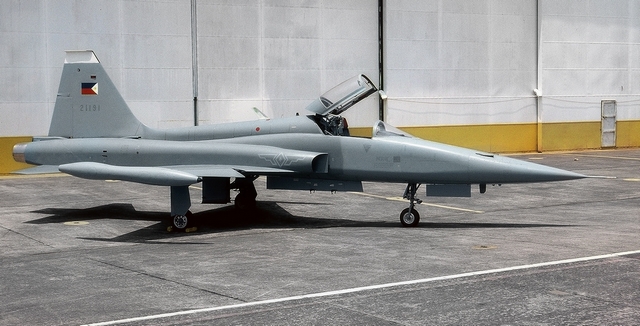 Photo: Archive The Northrop
F-5 Enthusiast
Photo: Archive The Northrop
F-5 Enthusiast
Spectacular two-tone gray Northrop F-5A 21191 initially painted for the
official retirement ceremony on 30-09-05.
It was actually repainted before the ceremony in
"normal" gray colours to better represent the operational aircraft.
Photo: Archive The Northrop
F-5 Enthusiast
Some of the remaining aircrafts are preserved at various Bases and at
the Philippine AF museum (see serials lists), others were still in storage at Clark AB in
2009.
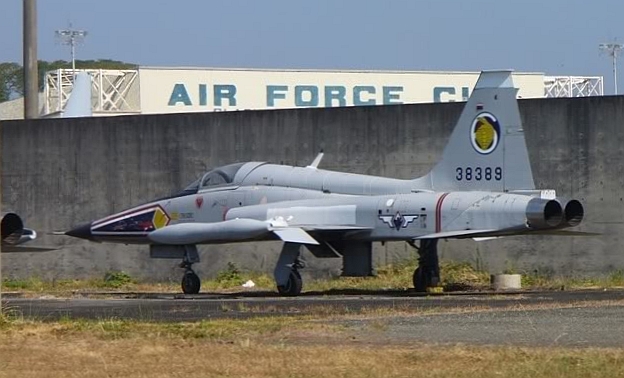 Photo: Paolo Maceren
Photo: Paolo Maceren 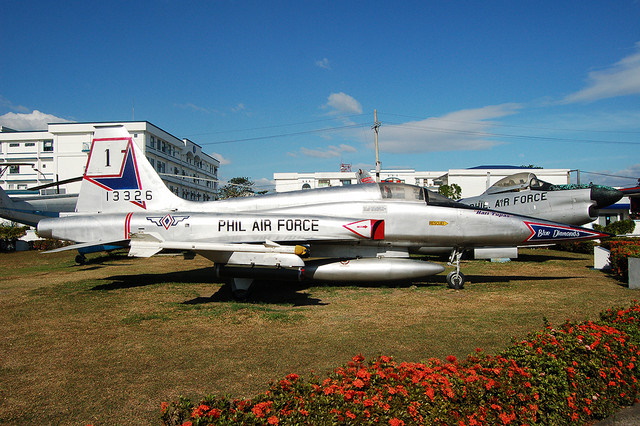
Northrop F-5A 38389
stored at Clark AB, "Blue Diamonds" and Philippine Air Force
inscriptions overpainted.
Northrop F-5A 13326 in original metallic colour and Blue Diamonds colours at the
Manila-Villamor AB museum in June 1993.
Photo: Mike
Barker
The Philippine Air Force conducted in 2008 a swap
with the Royal Thai Air Force of Northrop F-5A, F-5B spare parts and
hulks against spare parts for the local North American OV-10C Bronco
COIN aircrafts.
Six
newly grey painted (without engines) Northrop F-5A were shown at
Clark AB on 02nd November 2016, 11 years after the last aircraft was
withdrawn from service. In 2015 deliveries had started of
the new fighter/trainer KAI TA-50!


 Photo: Archive The Northrop F-5 Enthusiast
Photo: Archive The Northrop F-5 Enthusiast

 Photo: Archive The Northrop F-5 Enthusiast
Photo: Archive The Northrop F-5 Enthusiast

 Photo: Archive The Northrop F-5 Enthusiast
Photo: Archive The Northrop F-5 Enthusiast





 Photo: Militaryimages.net
Photo: Militaryimages.net 

 Photo: Archive The Northrop F-5 Enthusiast
Photo: Archive The Northrop F-5 Enthusiast Photo: Archive The Northrop F-5 Enthusiast
Photo: Archive The Northrop F-5 Enthusiast




 Photo: Peter Steinemann
Photo: Peter Steinemann

 Photo: Archive The Northrop
F-5 Enthusiast
Photo: Archive The Northrop
F-5 Enthusiast Photo: unknown
Photo: unknown Photo: Archive The Northrop
F-5 Enthusiast
Photo: Archive The Northrop
F-5 Enthusiast Photo: Paolo Maceren
Photo: Paolo Maceren 